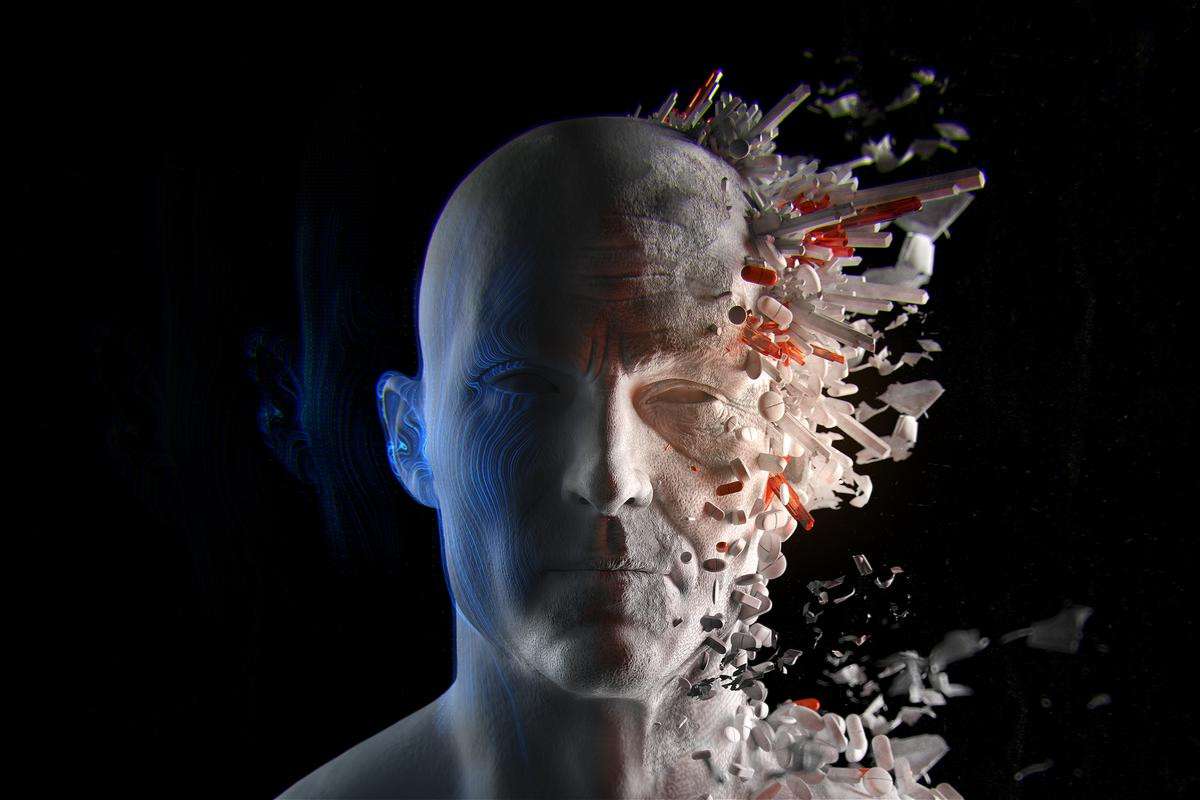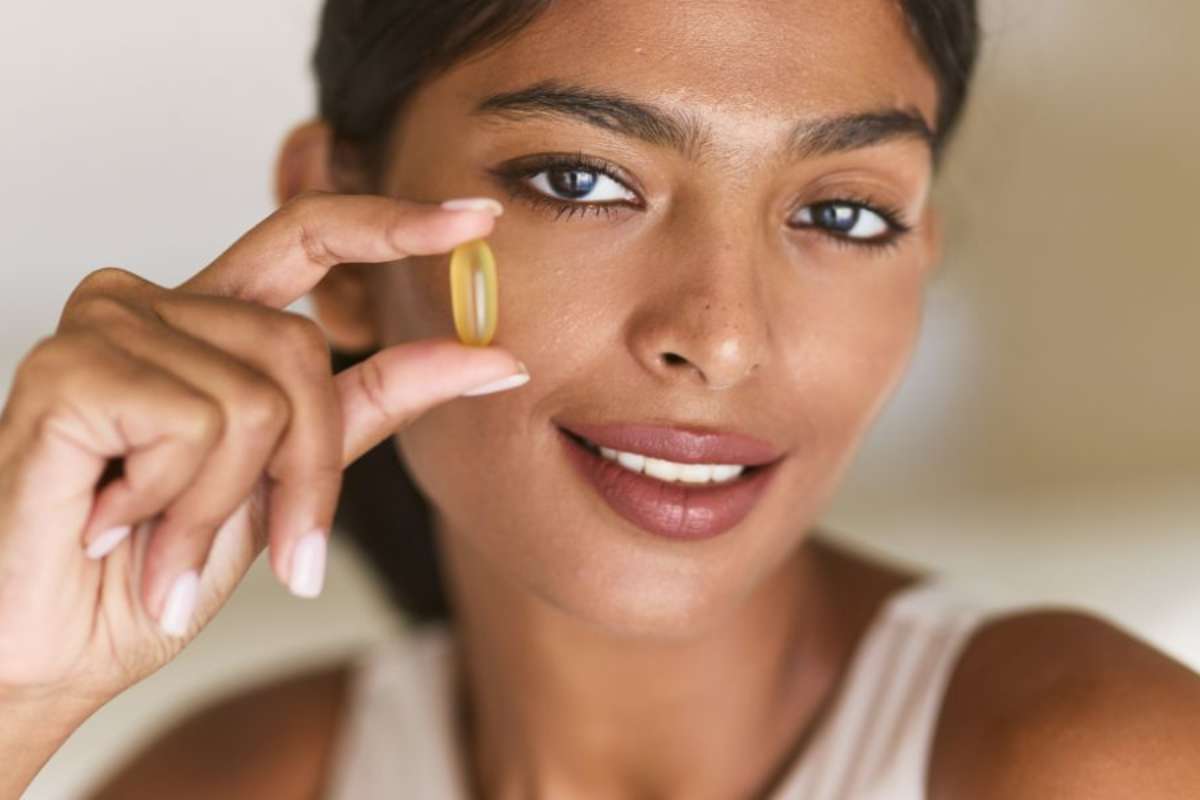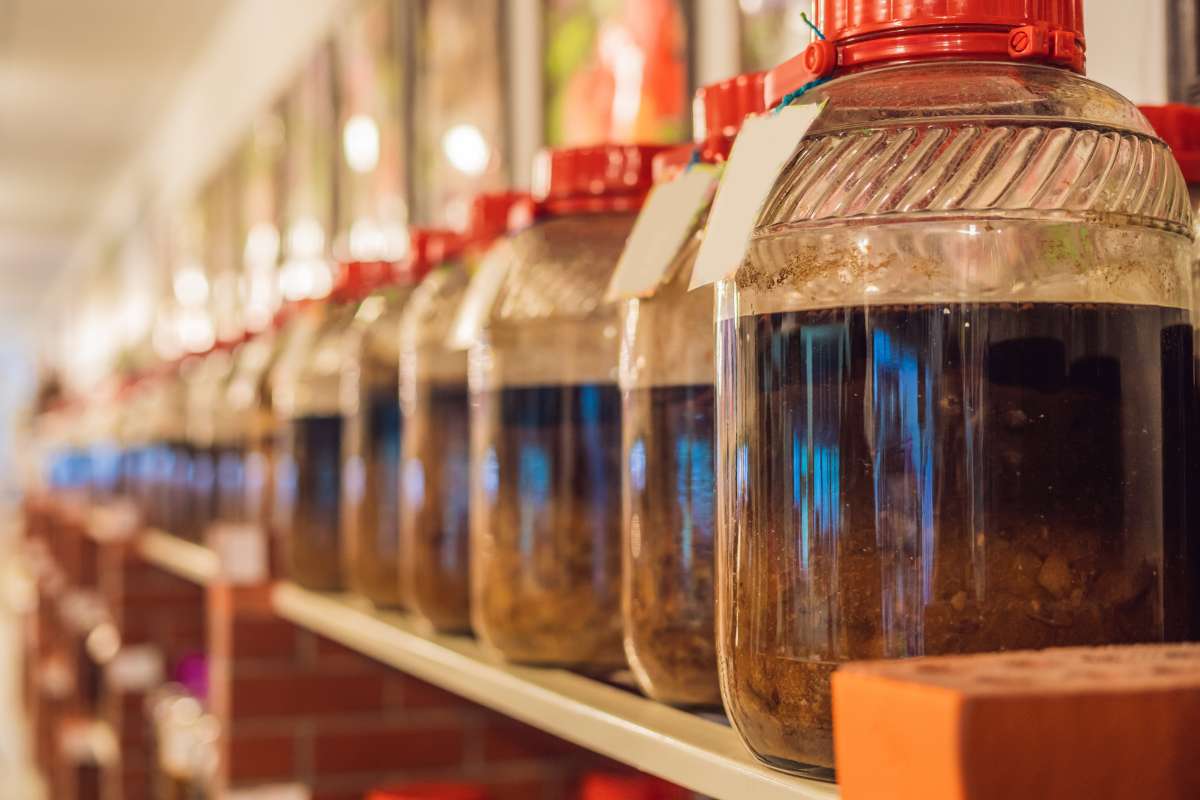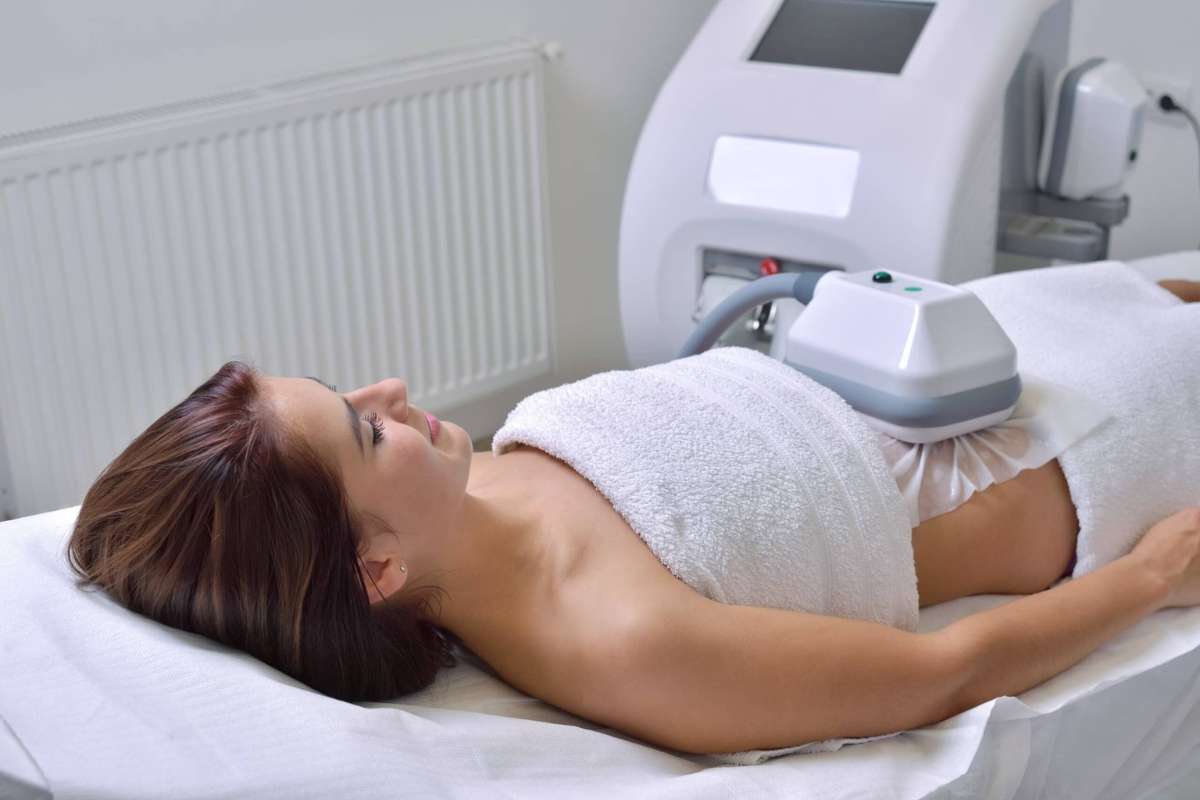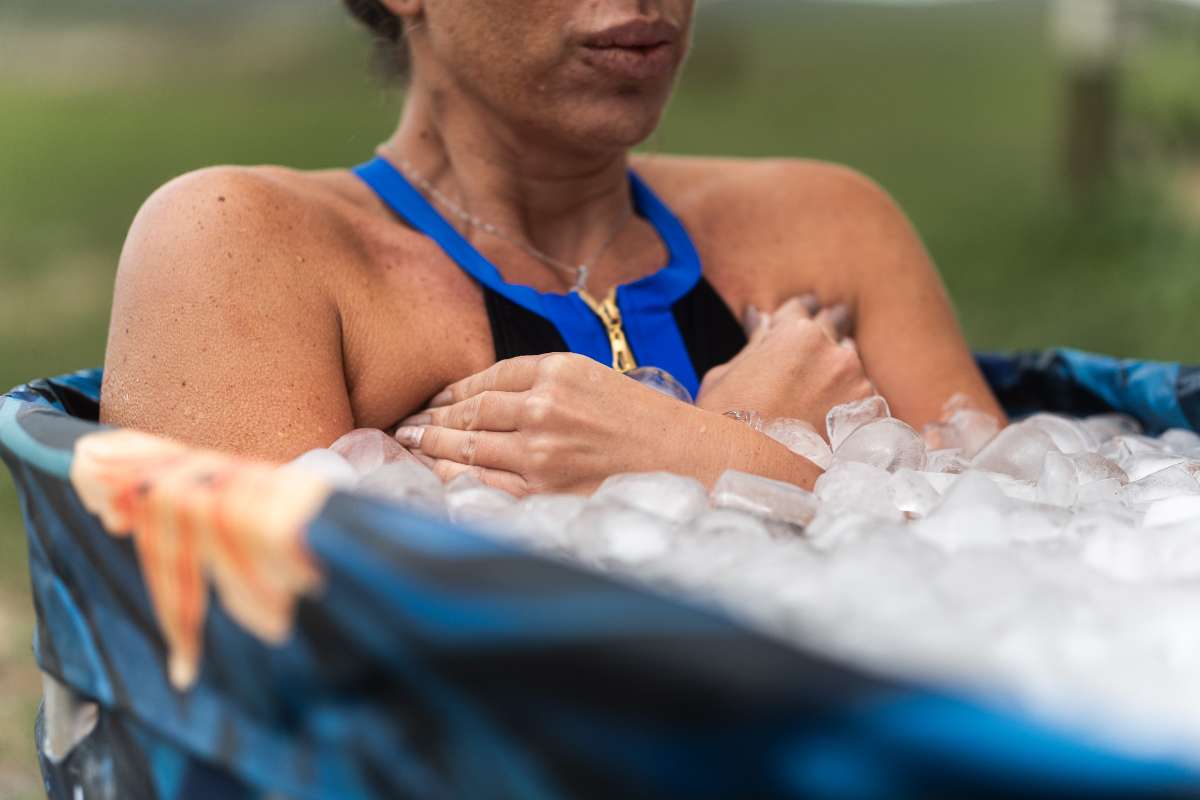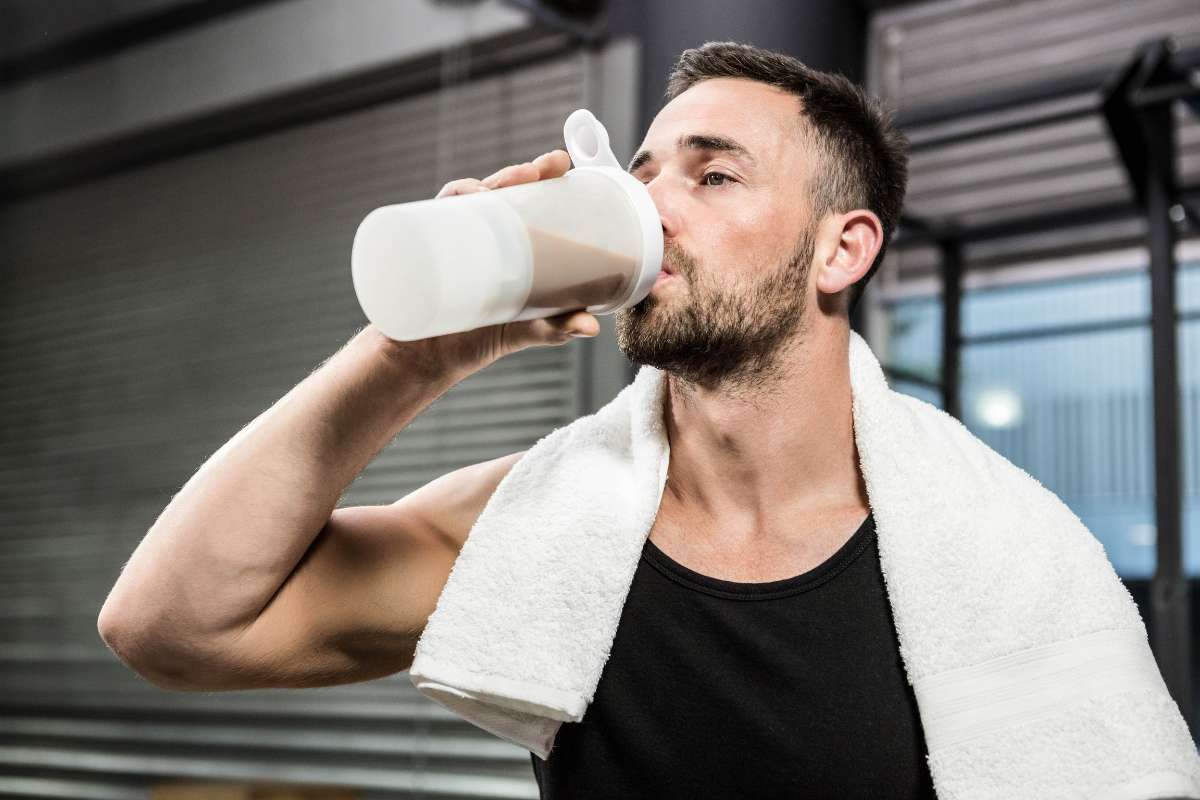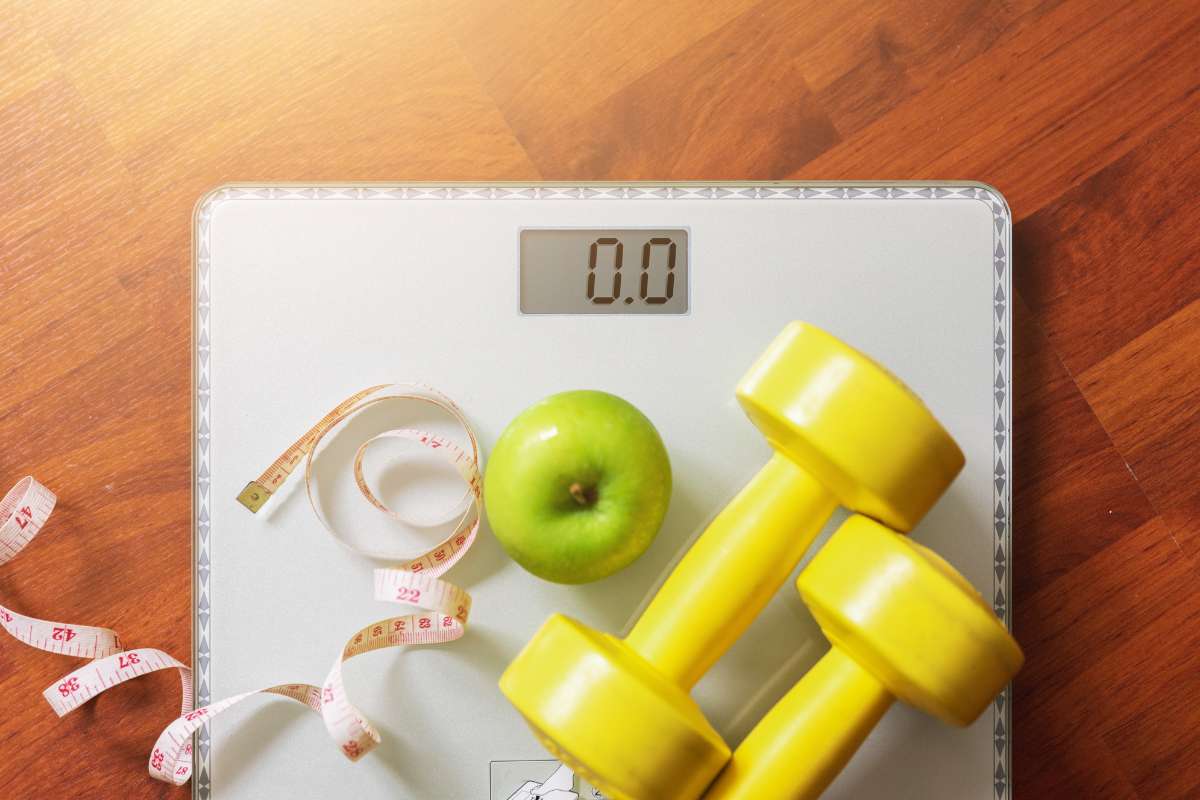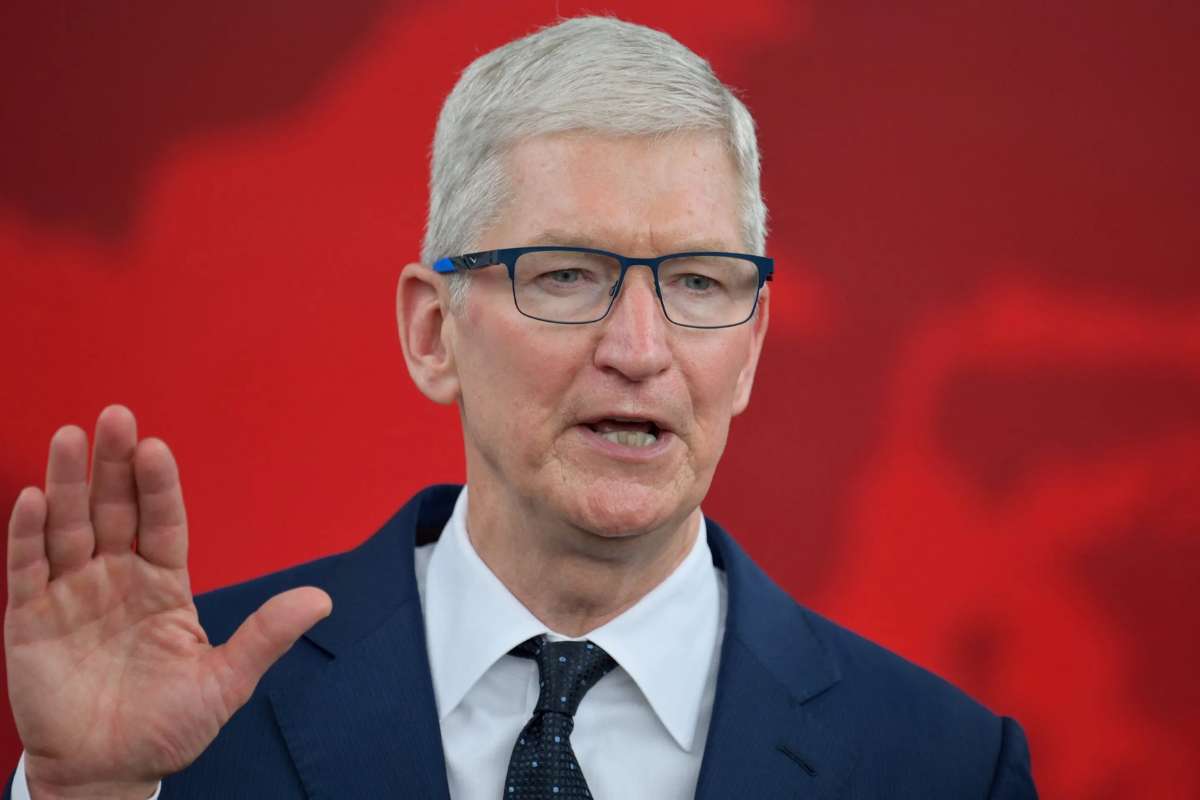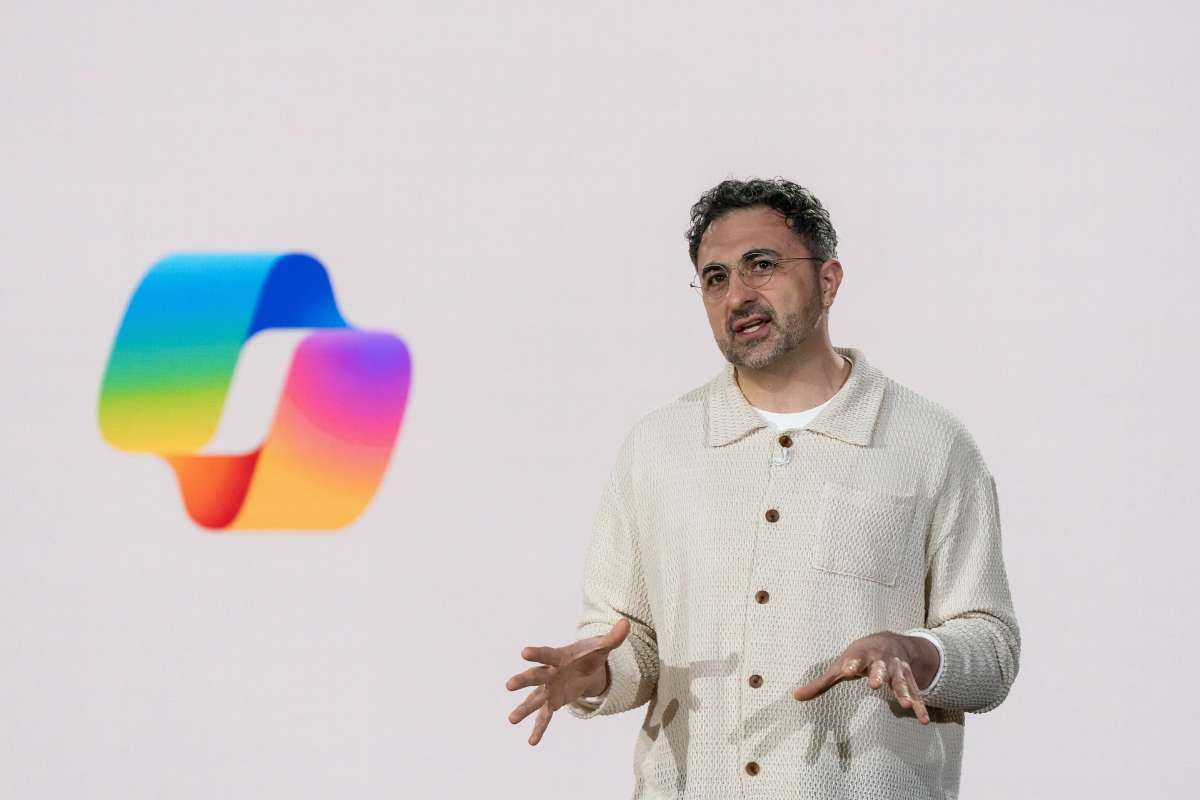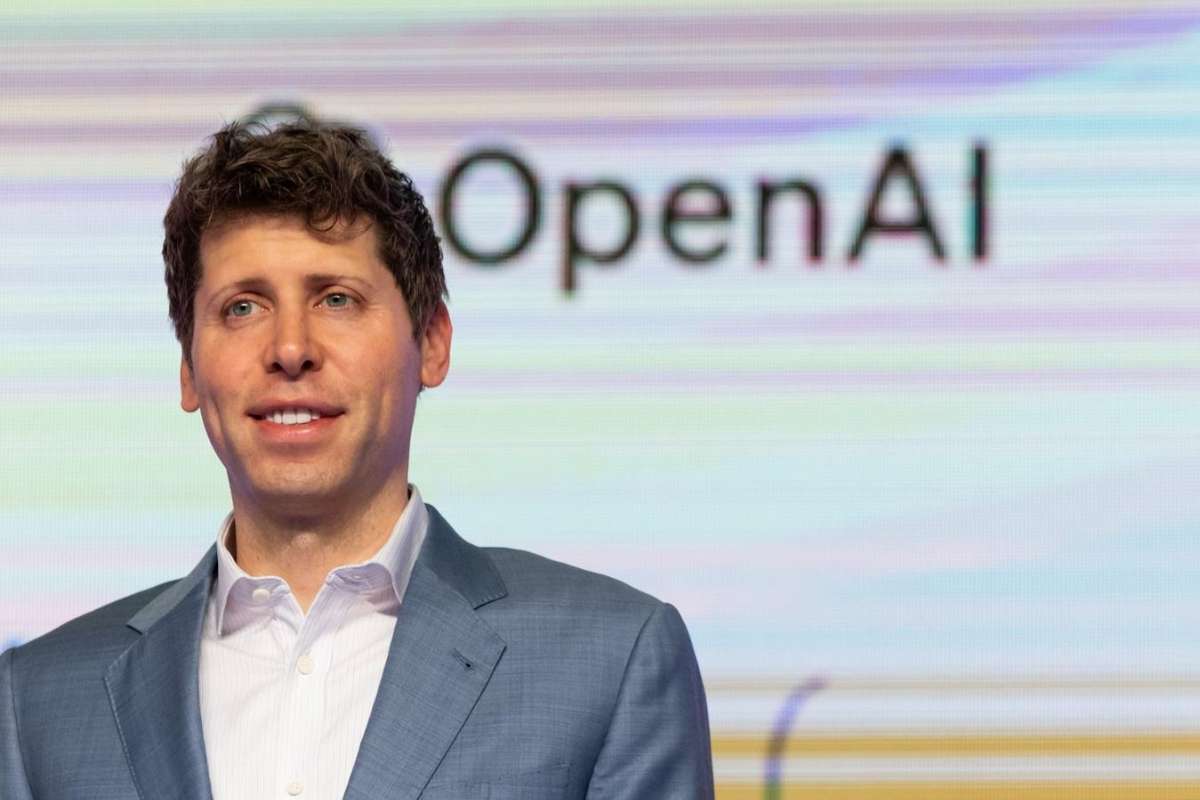What if you could upgrade your body and mind like software? That’s biohacking.
Ever wondered what is biohacking and why it’s becoming a buzzword in health and productivity circles? Simply put, biohacking is the art and science of upgrading your body and mind using small, deliberate lifestyle, dietary, and technological tweaks. In fact, the global biohacking market is set to surpass $13 billion by 2030, driven by wearables, smart nutrition, and personalized health tech.
Biohacking is all about small, deliberate changes: tracking sleep, optimizing diet, or using nootropics to sharpen the mind. Studies show that simple hacks, like better sleep and nutrition, can improve cognitive performance by up to 20%.
For professionals, especially in high-stakes roles, understanding what biohacking is can provide a real competitive edge, enhancing focus, productivity, and long-term health. Whether you want to start with lifestyle tweaks or explore advanced interventions like neurofeedback, biohacking is your roadmap to becoming a better, faster, healthier you.
➣ Why Biohacking Matters?
So, what is biohacking really? Beyond the hype, it’s a practical, science-backed approach to taking control of your body and mind. Biohacking helps you perform better, think clearly, and live healthier. For entrepreneurs, tech leaders, and professionals, it’s not just experimentation it’s a tool to unlock your full potential.
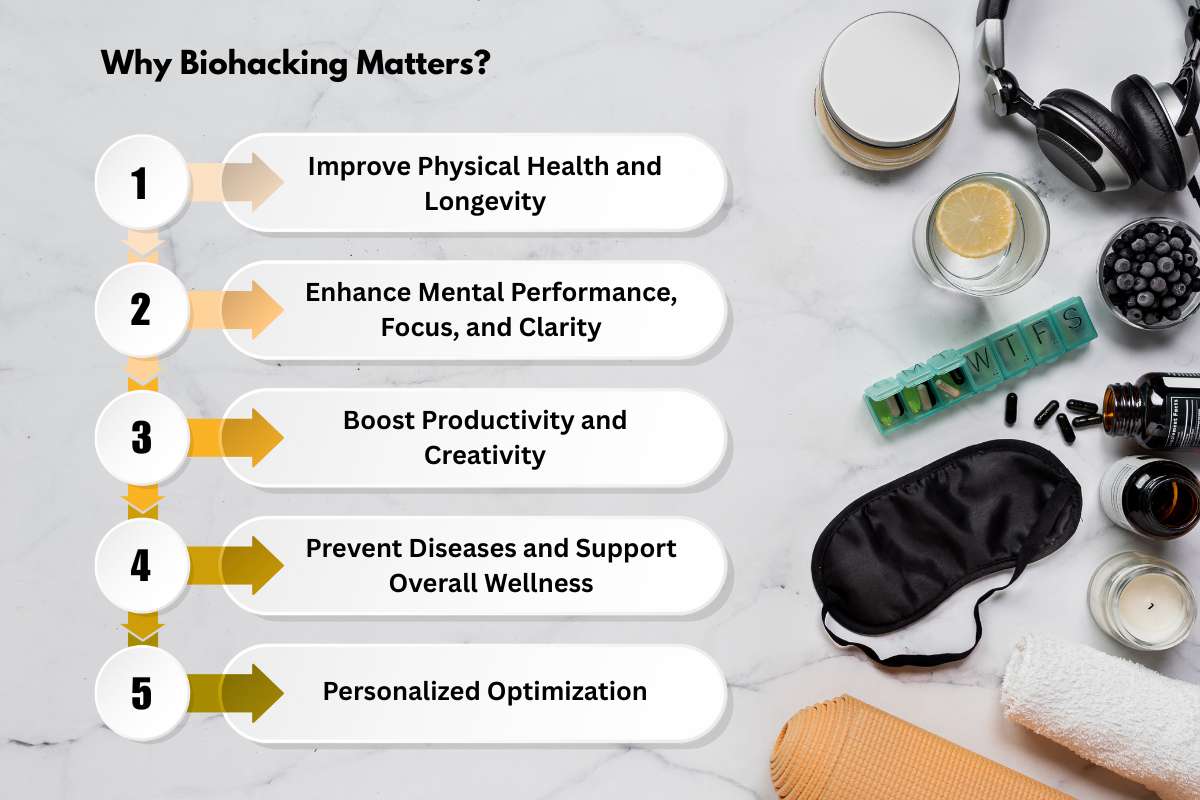
1. Improve Physical Health and Longevity
Small changes like optimizing sleep, fine-tuning your diet, and staying active can drastically improve overall health. Research shows targeted lifestyle interventions reduce the risk of chronic diseases and support longer, more energetic lives. Biohacking offers a clear roadmap to measurable improvements.
2. Enhance Mental Performance, Focus, and Clarity
Through mindfulness, nootropics, or deep work sessions, what is biohacking demonstrates how small interventions can boost attention and decision-making by up to 25%.
3. Boost Productivity and Creativity
Biohacking isn’t just about health; it’s about maximizing daily performance. Tracking energy, managing stress, and aligning routines with your body’s natural cycles can transform long workdays into highly productive sessions.
4. Prevent Diseases and Support Overall Wellness
At its core, what is biohacking emphasizes prevention. Optimizing gut health, nutrition, and stress management builds resilience, keeping your body strong and your mind sharp.
5. Personalized Optimization
One of biohacking’s most powerful aspects is personalization. Wearable data, health apps, and lab tests allow you to create a plan tailored to your unique physiology and lifestyle. This ensures every hack delivers maximum impact.
In short, biohacking is more than a trend; it’s a personalized, data-driven approach to optimizing life. Understanding what is biohacking transforms it from theory into practical, everyday applications for improved performance, health, and focus.
➣ Categories of Biohacking
Once you understand what is biohacking and why it matters, the next step is exploring the different ways you can apply it. Biohacking spans lifestyle, diet, cognition, and technology, allowing anyone to choose strategies that match their goals and comfort level.
| Category | Focus Area | Examples / Hacks | Benefits |
| Nutritional & Dietary | Diet & Supplements | Intermittent fasting, keto diet, probiotics, and omega-3 supplements | Boost energy, improve gut health, enhance cognitive function |
| Lifestyle & Environmental | Daily Routines & Surroundings | Sleep optimization, exercise, light exposure, stress management, and standing desks | Better mood, productivity, energy, and overall wellness |
| Cognitive & Mental Performance | Brain & Mind | Meditation, nootropics, brain-training apps, deep work sessions | Improved focus, memory, creativity, and decision-making |
| Technological & DIY Biology | Measurement & Innovation | Wearables, sleep trackers, neurofeedback, genetic testing, microbiome experiments | Track, analyze, and optimize biology; personalized health insights |
| Integrative Approach | Combination of Categories | Sleep tracking + diet optimization + meditation | Synergistic improvements in energy, focus, and overall performance |
Most effective biohackers combine these categories—for example, tracking sleep (tech) + improving diet (nutrition) + meditation (cognitive). This demonstrates what is biohacking.
➣ A Timeline Approach: From Beginner to Advanced Biohacking
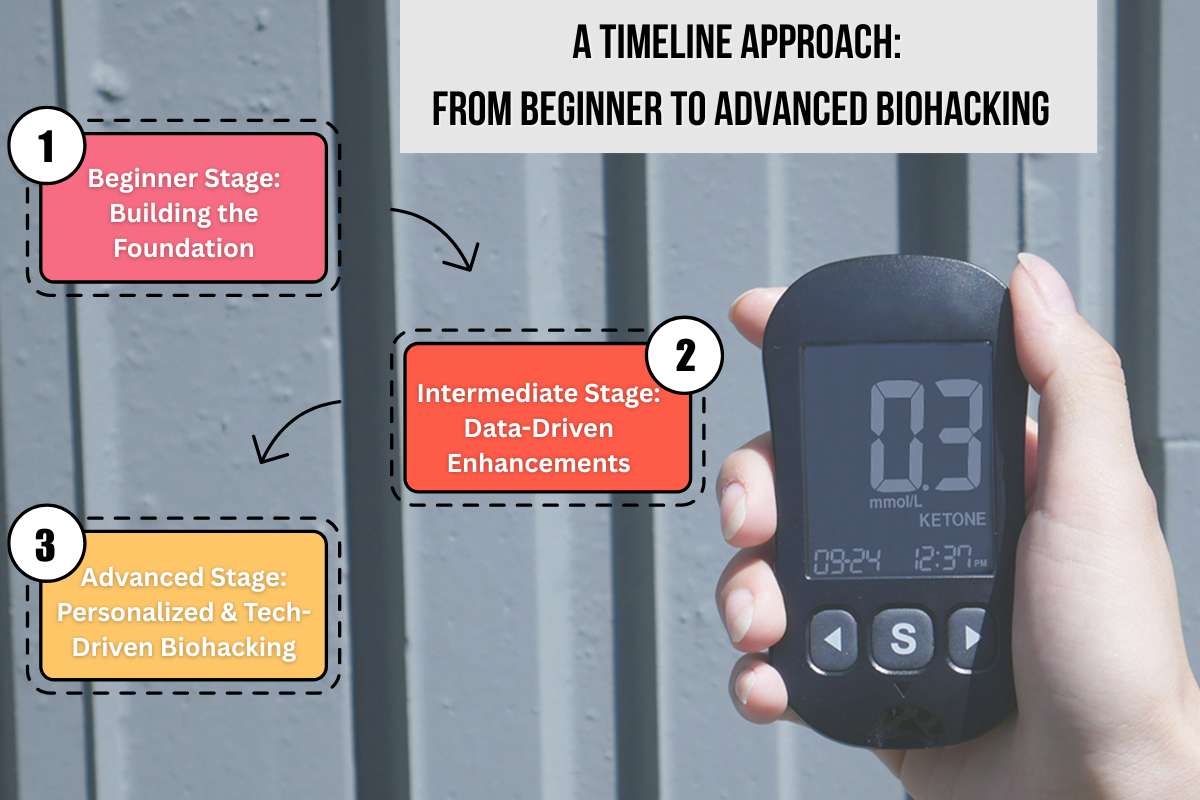
Biohacking doesn’t have to be overwhelming. You can start small and gradually adopt more advanced strategies as you learn what works best for your body and mind. Think of it as a roadmap: each stage builds on the previous one, helping you optimize performance, energy, and wellness step by step.
1. Beginner Stage: Building the Foundation
| Focused Area | Lifestyle & Nutrition Basics |
| Expected Benefits | Improved energy, better mood, foundation for further optimization |
This stage focuses on simple, high-impact changes that almost anyone can start immediately:
- Sleep and hydration: Track sleep patterns and aim for consistent rest. Staying hydrated boosts energy and cognitive clarity.
- Diet basics: Include more whole foods, vegetables, and nutrient-rich meals. Avoid processed foods and excessive sugar.
- Mindfulness practices: Even 5–10 minutes of meditation or deep-breathing exercises can reduce stress and improve focus.
Why it works: These habits create a solid foundation for more advanced biohacks, ensuring your body is primed for measurable improvements.
2. Intermediate Stage: Data-Driven Enhancements
| Focused Area | Data & Cognitive Hacks |
| Expected Benefits | Enhanced focus, memory, productivity, and health improvements |
Once your basics are in place, you can leverage data and targeted interventions to optimize performance:
- Intermittent fasting & nutrition hacks: Improve metabolic health and mental clarity.
- Targeted supplements: Omega-3s, magnesium, or probiotics can support brain function and gut health.
- Wearables & tracking apps: Devices for heart rate, activity, sleep, or focus allow you to monitor progress and adjust strategies.
Why it works: By using measurable data, you move from guesswork to precision optimization, enhancing both body and mind.
3. Advanced Stage: Personalized & Tech-Driven Biohacking
| Focused Area | Personalized & Tech-Driven |
| Expected Benefits | Peak cognitive and physical performance, personalized health optimization, longevity benefits |
At this stage, biohacking becomes highly personalized, often leveraging cutting-edge technology:
- Genetic testing & microbiome analysis: Understand your unique biology and tailor nutrition, exercise, and supplements.
- Neurofeedback & biofeedback devices: Monitor brain activity, heart rate variability, and stress responses in real time.
- Integration of multiple hacks: Combine cognitive, lifestyle, nutrition, and tech-based hacks for maximum impact.
Why it works: Advanced biohacking optimizes every aspect of performance, from physical health to cognitive function, providing long-term benefits in productivity, focus, and longevity.
This progressive approach ensures biohacking is safe, measurable, and sustainable, helping anyone from beginners to professionals like CIOs gradually unlock their full potential. By following this roadmap, you can experiment, track results, and continuously improve, making biohacking a practical part of everyday life.
➣ What Is Biohacking Through Practical Lifestyle & Dietary Examples?
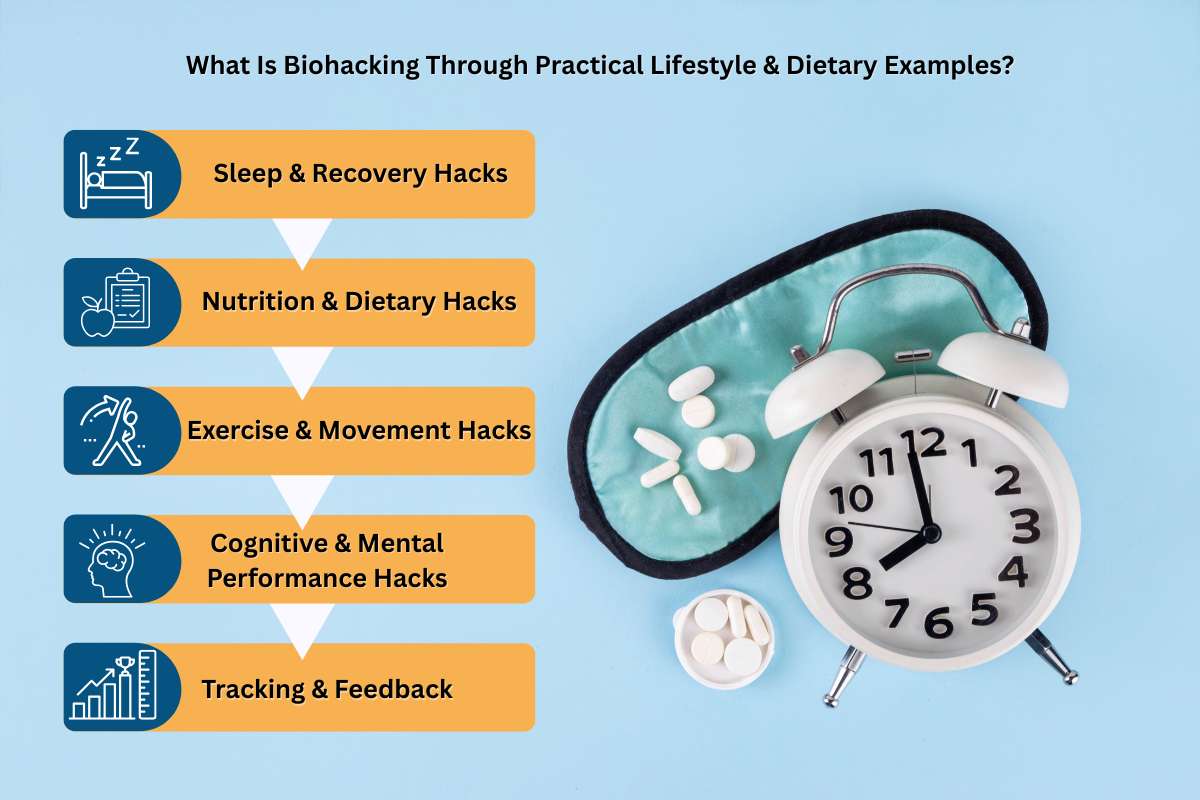
Biohacking becomes truly powerful when you apply evidence-based strategies in daily life. From diet and exercise to cognitive performance, these practical examples are backed by research and designed for measurable results.
1. Sleep & Recovery Hacks
- Track your sleep: Wearables like Fitbit or Oura Ring help monitor sleep cycles. Research shows that 7–8 hours of sleep per night improves memory, mood, and immune function.
- Optimize your environment: Studies indicate that reducing blue light exposure before bed and maintaining a cool room temperature (18–20°C) enhances deep sleep.
- Power naps: A 10–20 minute nap can boost alertness by 34% and improve cognitive performance, according to NASA research on pilots.
2. Nutrition & Dietary Hacks
- Intermittent fasting: Clinical trials suggest intermittent fasting can improve insulin sensitivity, support brain health, and enhance focus.
- Targeted supplements:
- Omega-3 fatty acids improve memory and cognitive function.
- Vitamin D supports immunity and mental health.
- Probiotics can modulate the gut-brain axis, influencing mood and stress response.
- Balanced meals: Prioritize lean proteins, whole grains, vegetables, and healthy fats for sustained energy and cognitive clarity.
- Hydration: Even mild dehydration (~2%) can reduce cognitive performance; aim for 2–3 liters of water daily, depending on activity and climate.
3. Exercise & Movement Hacks
- Strength training & HIIT: Meta-analyses show resistance training increases metabolism, improves cardiovascular health, and enhances mental well-being.
- Yoga & stretching: A 2022 study found that an 11-minute short form of Yoga Nidra led to reductions in total cortisol concentration and steeper diurnal slopes, suggesting improved adaptive capability to stress.
- Micro-movements: Taking short standing or walking breaks every 60–90 minutes can prevent fatigue, boost circulation, and improve productivity.
4. Cognitive & Mental Performance Hacks
- Meditation & mindfulness: Research in JAMA Internal Medicine shows mindfulness can reduce anxiety by up to 20% and improve attention span.
- Deep work sessions: Structured focus periods, free of distractions, increase productivity by up to 40%, according to Cal Newport’s studies.
- Brain-training apps & nootropics: Evidence supports targeted cognitive exercises for memory, focus, and learning efficiency. Nootropics like L-theanine + caffeine have been shown to improve cognitive performance and mood.
5. Tracking & Feedback
- Wearables and apps provide real-time insights into sleep, activity, nutrition, heart rate variability, and stress levels.
- Journaling and analytics: Tracking habits over time helps identify patterns, adjust strategies, and optimize performance.
- Example: CIOs using wearables like WHOOP have reported sharper decision-making during intense projects; proof that what is biohacking is not just theory but practical performance science.
By integrating sleep optimization, targeted nutrition, movement, cognitive hacks, and data tracking, you create a personalized, sustainable biohacking routine. Evidence shows that even incremental adjustments in these areas can boost cognitive performance by 15–25%, reduce stress, and enhance overall health.
➣ How CIOs and Professionals Can Apply Biohacking Daily?
For busy professionals like CIOs, “what is biohacking?” is just a wellness trend; it’s a strategic advantage. Optimizing your body and mind can directly impact productivity, decision-making, and resilience in high-pressure environments.
Here’s a practical, evidence-backed daily approach, illustrated with real-life examples of executives and tech leaders who integrate biohacking into their routines.
1. Cognitive Enhancement for Peak Performance
- Time-blocked deep work: Structured focus periods can improve productivity by up to 40%. For example, Elon Musk and Bill Gates famously schedule focused, distraction-free blocks to tackle their most critical tasks.
- Brain-boosting nutrition: Foods rich in omega-3s, antioxidants, and complex carbs support focus and memory. Marc Andreessen, co-founder of Andreessen Horowitz, emphasizes a diet that fuels sustained mental energy during long workdays.
- Micro-breaks: Short breaks every 60–90 minutes help maintain alertness. CIOs at leading tech firms use quick walks or stretching to reset and maintain productivity.
2. Stress Management and Emotional Resilience
- Mindfulness & meditation: 10–20 minutes daily can reduce stress by 20%, improve emotional control, and enhance executive function. Ray Dalio, founder of Bridgewater Associates, credits meditation with helping him stay calm under high-stakes pressure.
- Breathwork & micro-pauses: Quick deep-breathing exercises stabilize heart rate and lower cortisol. Professionals like Arianna Huffington integrate these mini-breaks to maintain focus.
- Optimized workspace environment: Adjustable lighting, ambient noise control, and ergonomic setups reduce stress and enhance focus.
3. Physical Optimization for Energy and Health
- Morning movement: Even 20–30 minutes of light exercise improves circulation, mental clarity, and energy for the day. Jeff Bezos incorporates daily workouts to maintain physical and cognitive stamina.
- Posture and ergonomics: Standing desks, ergonomic chairs, and stretching routines prevent fatigue and musculoskeletal strain.
- Sleep prioritization: Quality sleep correlates with better decision-making; top executives like Satya Nadella emphasize sleep as critical for performance and leadership clarity.
4. Data-Driven Insights for Continuous Improvement
- Wearables & apps: Tools like Oura Ring, WHOOP, or Garmin provide real-time insights into sleep, heart rate variability, and activity levels. CIOs at global tech firms use this data to optimize energy cycles and work schedules.
- Track and adjust: Regularly analyze trends to refine routines when to sleep, eat, or exercise to match peak energy windows.
- Feedback loops: This ensures biohacking aligns with high-stakes responsibilities, helping leaders maintain sustained productivity and mental clarity.
5. Integrating Biohacking into a Professional Routine
- Morning: Hydration, 10–15 min meditation, light exercise.
- Work hours: Time-blocked deep work, strategic breaks, brain-boosting meals, energy tracking.
- Evening: Sleep optimization, light reduction, gentle stretching, journaling to reflect on performance metrics.
By applying biohacking daily and strategically, professionals can enhance focus, energy, and resilience. Real-life examples from top executives show that even small, data-driven lifestyle adjustments can lead to measurable improvements in cognitive performance, stress reduction, and overall productivity, turning biohacking from a wellness trend into a powerful professional advantage.
➣ Further Exploration & Advanced Biohacks
Once you understand the basics of what is biohacking, the next step is diving into advanced techniques that push the boundaries of human performance. These go beyond diet tweaks or meditation apps and venture into technology-driven solutions, data analysis, and scientific experimentation. While not all methods are suitable for everyone, they highlight where the future of health and productivity may be heading.
Basic vs. Advanced Biohacks at a Glance
| Category | Basic Biohacks | Advanced Biohacks |
| Physical Health | Balanced diet, regular exercise, hydration | Continuous glucose monitors, genetic testing |
| Mental Clarity | Meditation, journaling, and sleep hygiene | Nootropics, brain stimulation devices |
| Recovery | Stretching, rest, and natural supplements | Cryotherapy, infrared saunas, red light therapy |
| Monitoring | Step counters, simple fitness apps | Wearables like WHOOP/Oura, AI-driven health platforms |
| Community | Online health forums | Biohacking labs, Quantified Self community |
1. Wearable Technology and Continuous Monitoring
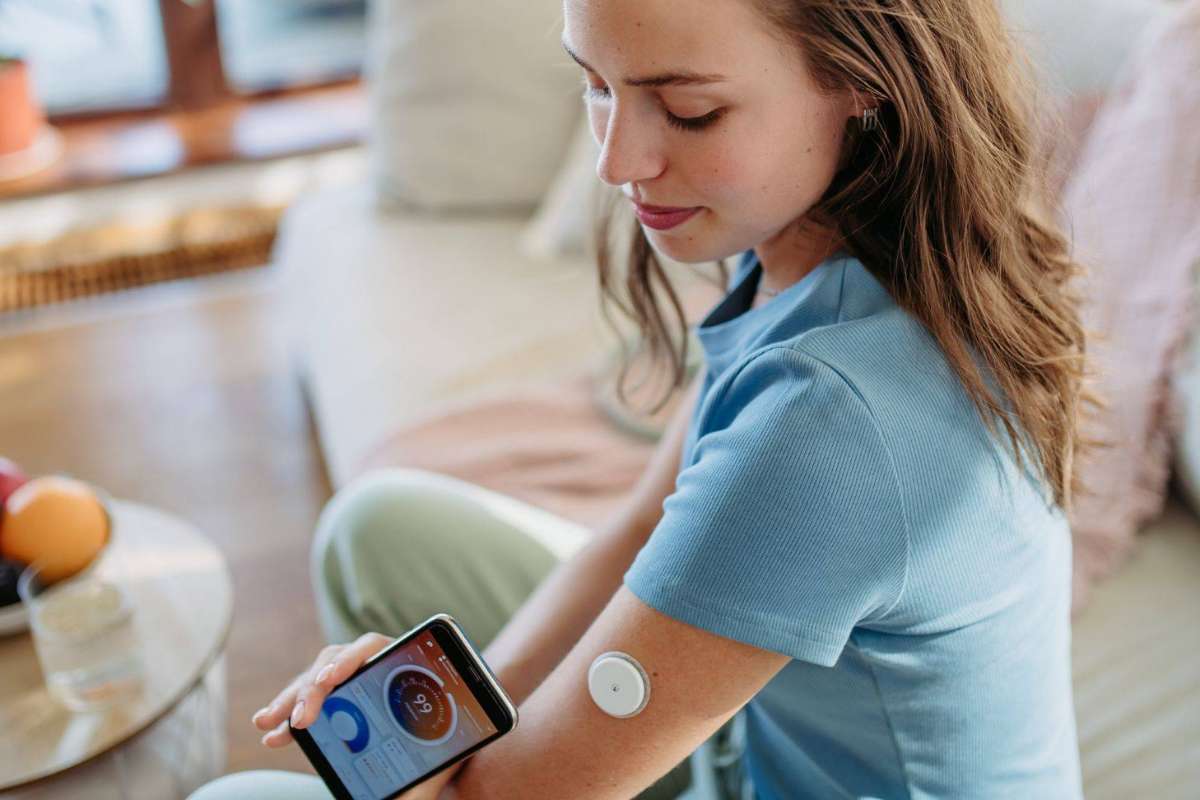
Modern biohackers use tools like continuous glucose monitors (CGMs), Oura Rings, or WHOOP bands to collect real-time data on sleep, stress, and metabolic health. According to a 2024 report by Grand View Research, the global wearable tech market is projected to surpass $186.14 billion by 2030, proving how central data-driven health has become.
2. Genetic Testing and Personalized Health
DNA-based testing (like 23andMe or InsideTracker) provides insights into genetic predispositions for nutrition, fitness, or potential disease risks. Athletes increasingly rely on these tools for hyper-personalized training and recovery programs. It’s prevention and performance rolled into one.
3. Nootropics and Cognitive Enhancers
From natural supplements like Lion’s Mane mushroom to prescription compounds like Modafinil (under medical guidance), cognitive biohacks target sharper memory and deeper focus. A Deloitte survey in 2023 revealed that 40% of knowledge workers experiment with nootropics to stay competitive.
4. Light, Cold, and Heat Therapy
Red light therapy, cryotherapy, and infrared saunas are redefining recovery. Elite athletes like Cristiano Ronaldo have publicly shared their use of cryotherapy chambers to maintain peak fitness and quick recovery.
5. Biohacking Communities and Experimentation
Advanced biohackers gather in global hubs like Biohack.me and the Quantified Self movement, exchanging experiments and data openly. While this collective innovation fuels progress, it also reminds us of the ethical and safety boundaries in experimentation.
Conclusion
At its core, what is biohacking comes down to one idea: using science, technology, and lifestyle choices to unlock better versions of ourselves. From simple habits like sleep and nutrition to advanced tools like wearables, nootropics, and genetic testing, biohacking offers a spectrum of ways to boost health, focus, and longevity.
The key is balancing choosing what works for your body, guided by data and credible science. For CIOs, professionals, and everyday learners alike, biohacking isn’t about chasing extremes; it’s about sustainable growth and smarter living. Ultimately, it’s less about hacking life and more about building a healthier, sharper, and more resilient one.
FAQs: What is Biohacking?
1. What is biohacking in simple terms?
A science-backed approach to improving health, cognition, and productivity through lifestyle, diet, and technology.
2. Is biohacking safe for everyone?
Most beginner lifestyle and dietary hacks are safe, but advanced interventions like genetic editing should be done under professional guidance.
3. Can biohacking really improve work performance?
Yes, evidence shows optimized sleep, nutrition, and focus strategies can enhance cognitive performance and productivity.
4. Do I need expensive tools or supplements to biohack?
Not necessarily. Many effective hacks are simple lifestyle changes like sleep management, exercise, and diet tracking.
5. How do I start biohacking as a beginner?
Begin by tracking your sleep, hydration, and diet. Gradually integrate small routines and experiment with supplements or wearable tech.
6. Are there risks involved in biohacking?
Risks increase with advanced interventions; consult healthcare professionals and rely on credible resources to minimize harm.

